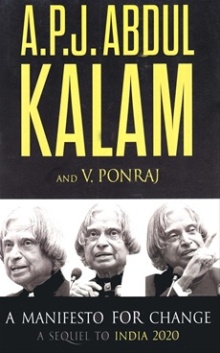
Dr APJ Abdul Kalam, the 11th president of India, has always been a visionary and has passionately served the country with his leadership. This is evident by the fact that even after his presidency he continued to work for the betterment of the society by taking up research and development activities and interacting with the youth of the nation and encouraging them to actively participate in developing the country. His last words were those to the students of IIM Shillong.
Dr Kalam’s passion for working for the nation is mirrored in his book “A manifesto for change”, co-authored with V. Ponraj, an ADA scientist and former technical advisor during Dr. Kalam’s presidency. The book is very timely written and enumerates, with facts and figures, the current socio-economic scenario of the Republic of India.
The book kicks off with a whole chapter on “creative leadership” and how it has and can help in the development of the nation. It then builds upon the different levels of leadership in India, starting from Panchayats and moving on to the central government. It delineates the development areas that need to be concentrated on at the village, state and central level. The book ends with a “vision for India”.
I would give this book 5 out of 5 stars and that is because when I picked up this book I was like every other youth in this country who propounds the rhetoric of developing the country but is vaguely aware of the facts and figures. I am now well versed with how my country has performed in the past three decades and what steps need to be taken to elevate my country’s status to a developed nation. This book, in very simple language, gives an in-depth analysis of the following:
- How has India performed over the past years; which states have fared well and which need to improve.
- An emphasis on the PURA (Providing Urban amenities to Rural Areas) model and how it can be used to bridge the economic divide between urban and rural areas and promote an integrated development environment.
- Initiatives to be taken at the Village level by tapping the full potential of Panchayati Raj. The authors narrate some examples as well of how creative leadership at the panchayat level has led to fruitful results.
- Initiatives to be taken at the state level. This section is heavily loaded on facts and figures and will give you an idea of the strengths and weaknesses of our states.
- Major development areas of the nation – with innovative suggestions like smart waterways systems and integrated agricultural, industrial and services sector development.
- Role of the government – MPs and MLAs – in developing the country and a chapter on how critical our parliament sessions are to ensure the country’s growth.
- Ways to improve the quality of life in addition to economic growth.
I would really commend the writing style of this book, the language is simple and succinct. If you wish to become aware and informed about the socio-economic aspects of India, this book is for you. In just 255 pages it covers important points and gives meaningful and well researched suggestions. I would highly recommend this book to the youth and encourage them to carry forward the vision of Dr. Kalam and bring this nation to the level at which it deserves to be.
K.A.